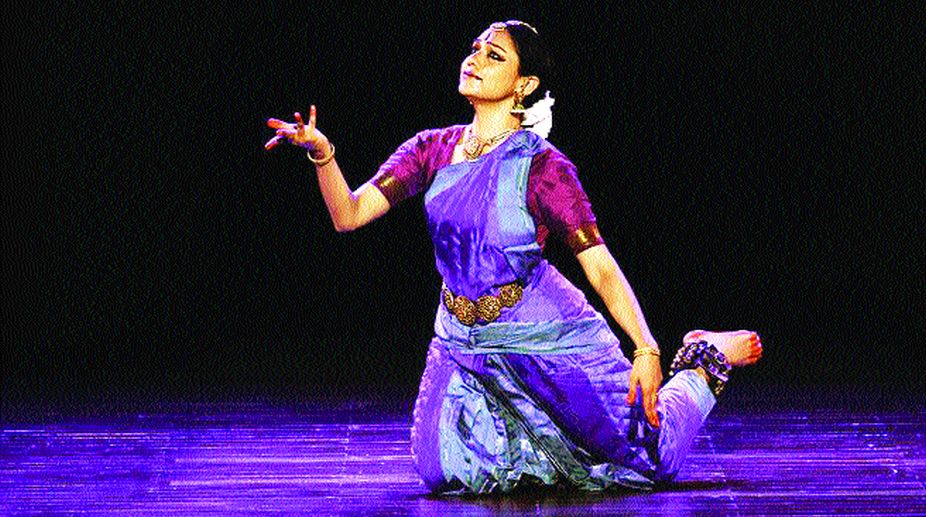Triyambaam: A tribute to goddesses
At the Madras Music Academy recently, the Sivamohanam School of Kuchipudi dance presented “Triyambaam”, an ode to the three goddesses of Hindu mythology—the Goddesses of knowledge, prosperity and energy.

On the fifth day of the Madras Music Academy’s festival of dance, the tremendously talented Mohiniattam exponent Neena Prasad, a student of Kalamandalam Sugandhi and Kalamandalam Kshemavathy, started her recital with Cholkettu in dhanyasi ragam and khanda jati talam. The music composer Changanasseri Madhavan Nampoothri was also a wonderful vocalist. Along with mridangist Ramesh Babu, violinist Easwar Ramakrishnan, edakka player Arun Das and veena player Murali Krishnan, he created an ambience that led rasikas to be temporarily transported to the beautiful land of Kerala.
The rendition of Swarajati on Devi in ragam bhairavi by Shyama Sastri was the ardent plea of the devotee seeking her benevolence. After Amba Kamakshi, a prayer to Devi, Prasad chose to showcase the astapadi, Kuru yadu nandana, a sambhoga sringara from Jayadeva’s Geet Govinda showing Radha’s remembrance of her union with Krishna. Moving like the gentle undulating ocean waves that Mohiniattam is famous for, Prasad covered the stage in a beautiful manner. The thillana in ragam thilang was marked by its aesthetic beauty and slow-paced swinging movements that is so characteristic of Mohiniattam.
Advertisement
On the penultimate day of the festival, the audience was treated with a performance from one of the best Bharatanatyam performers of the country. Rama Vaidyanathan traversed with ease from traditional to contemporary compositions while remaining true to the genre. A mallari based on five ragas, performed in well-defined Bharatanatyam style, was a not only a visual treat but also provided spiritual food for the soul. Leaping and sitting down before one could take a breath requires phenomenal balance.
Advertisement
The second piece was a rare varnam by the Tanjore quartet in athana ragam and adi talam. The sakhi entreating Shiva to look at her friend compassionately was rather compelling. The beautiful jathis were by Ramamurthy Ganesh. Having treated the audience to this very traditional piece, she led the audience to appreciate Vrikshanjali. She was stimulated to choreograph this piece when she saw falling trees — Vrikashnajali was an ode to the tree penned by her and translated into dance. The piece Ashe mukhayam maranda poch reminded this reviewer that acute anxiety is not a modern day phenomenon. The devotee’s anxiety in having lost her lord because she cannot recollect his face was genuinely portrayed.
Vaidyanathan rounded off with Surdas’ Murali nado sunayo — it was a rasleela where Rama ably created the necessary ambience with so many gopis dancing around Krishna, each under the impression that she is the sole one dancing with the lord.
Performer, choreographer and teacher, A Laksmanswamy, a disciple of KJ Sarasa performed the rare Manduka Sabdam and the varnam Ni Sati Dora, a composition of the Tanjore quartet. Priye Charushile from the Geet Govinda was successfully portrayed to melt Radha’s feeling of anger.
Like every year Nrityagram presented a set of dance pieces winning huge applause from the audience. The artistic director and her team of talented dancers took the stage performing good choreographic pieces one after the other, starting with a solo by Bijayini Satpathy in praise of Krishna with the devotee seeking his lotus feet. Surupa Sen’s Kesy hey madana udaram from Geet Govinda was sensuously delineated. The aura of the astapadi permeated through the hall and everyone was totally engrossed in the poetry that was depicted through dance. They ended with a stuti in a spectacular choreographic work to Goddess Mahisasuramardini.
Moving on, a five-day festival called Smritii Sankalan was a tribute to the legendary Guru Kelucharan Mohapatra, Guru Prahlad Das, Guru Kundanlal Gangani and Guru Chitresh Das. It was organised by Nandini Choudhury Mohanty in the Satyajit Ray Auditorium of ICCR, Kolkata. Mohanty’s Kathak Guru, Pandit RajendraGangani mesmerised the audience with his impeccable andaz in the Jaipur gharana Kathak. He entered the hall dramatically in the true fashion of a Kathaka. Gangani’s tradition chanting of Namami Shamishan Nirvana Rupam held the audience spellbound, ending with a rich and typical Jaipur gharana tatkar. It is unknown to nobody that Gangani is a senior Kathaka from a hereditary family of Kathak dancers. His father and guru Pandit Kundanlal Gangani and his granduncle Guru Narayan Prasad are stars of the Jaipur gharana kathak firmament.
Rajendra Gangani is a chip of the old block. The audience had a glimpse of his neat footwork over which he had absolute control. During fast renditions his sideward movements and the dragging of the toe at the end of a rhythmic passage to reach sam — the first beat of the cycle of the tala — was phenomenal. Sequences like Choot- ki-Uthan and the Journey of Dha paran, using intonations of the syllable dha to lengthen or shorten the beats to suit the gati changes; Gaj Paran, Barsha paran and Mayur paran were executed with fineness.
He went on to present a thumri in desh raag, Aaisi Hathila Chayan and it was a winner. The audience was swept off their feet with his performance. The superb tabla player who accompanied him ably was Fateh Singh Gangani, his brother. The vocal supporting artist was Debashish Sarkar while Sukhamoy Bhattacharya gave him support on the sitar. Umesh Mishra played the Sarangi. Divyani Mohanty, an Odissi dancer and disciple Nandinii Chaudhry Mohanty, performed Hamsadhwai Pallavi in tala malika choreographed by Guru Kelucharan Mohapatra the music for which was composed by Pandit Bhubaneshwar Mishra. Pallavi means to elaborate or “to flower” and is applicable to not only the dance but the accompanying music as well. It is an ornamental representation, marked by elegant and lyrical movements built up gradually into complex patterns through sequences. Mohanty did very well in this. On the other hand, Nandinii Chaudhury Mohanty performed both Odissi and Kathak. She is a disciple of Guru Pandit Rajendra Gangani. In Kathak, she performed a Krishna Bandana in rupak tala, choreographed by Rajendra Gangani, followed by Teentaal.
Advertisement